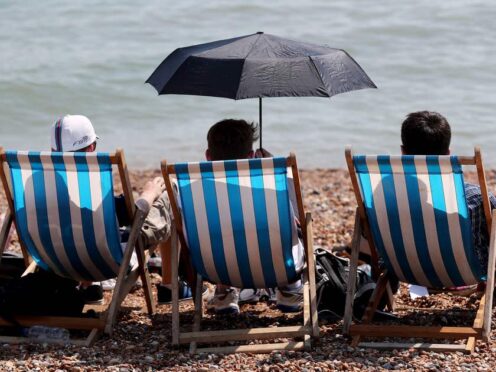
Heatwaves may hit parts of the UK next week after a grey start to the weekend, forecasters have said.
Friday is expected to be largely dry with sunny spells in most areas but with showers across Northern Ireland, Scotland and western England, the Met Office has predicted.
A “greyer start to the weekend” is forecast on Saturday with further showers and warm temperatures in the south and east of England before a “mainly nice day” for most areas of the UK on Sunday.
Temperatures are on the rise, especially into the first half of next week with widely settled and humid conditions 🌡️ pic.twitter.com/rWRyH15gtu
— Met Office (@metoffice) June 20, 2024
Hotter, more humid weather is forecast at the start of next week, with temperatures reaching the mid-20s and potential heatwaves across some areas in central and southern England.
But from Wednesday, the weather is likely to become “unsettled” with a potential for heavy showers and thunderstorms.
Warmer weather comes as the number of people visiting the NHS website for hay fever advice has more than doubled this week, according to health officials.
On Monday, temperatures are expected to reach a maximum of 27C in the north of England and 28C in the south and southeast of the country.
Met Office chief forecaster, Neil Armstrong, said: “Some central and southern areas are likely to see temperatures approaching the values needed for heatwave conditions.
“Heatwave conditions need to remain in situ for three consecutive days, and by the middle of next week it is possible that some parts of the UK could be reaching heatwave thresholds.

“However, whether or not everyone experiences heatwave thresholds, the majority of the UK will experience the finest conditions and highest temperatures so far this year.”
On the upcoming weekend, Met Office spokesperson Andrea Bishop, said: “It’s a greyer start for the weekend that we have been used to.
“There’s a band of cloud and patchy light rain or drizzle, turning showery as it clears eastward across England where most parts are dry with variable cloud and sunny spells.”
Temperatures are expected to reach high teens to low 20s Saturday evening, the forecaster said.
On Sunday morning, more cloud and drizzle is expected across Wales, central and southern England before sunnier conditions for the rest of the day, according to the Met Office.
The forecaster attributed the warmer temperatures to the jet stream – high velocity wind in the atmosphere which causes changes in pressure and helps shape the weather across the country.
Do you suffer from hay fever? 🤧
Pollen levels remain very high today and over the weekend 👇 pic.twitter.com/iDacTPVpM8
— Met Office (@metoffice) June 21, 2024
Ms Bishop added: “Generally speaking, the high pressure is building – heading up from the south-west bringing a mainly nice day for most of us on Sunday.
“The reason for the hot weather is, for most of June, the jet stream has been on the cool side of us.
“It’s now pushing northward and taking the low pressure systems up to the north, allowing high pressure to move in and bringing that warmer air to come.”
On Friday, NHS England, which runs the NHS.uk website, said the hay fever section of their website had been visited on average 11,736 times per day this week, compared to a daily average of 4,749 visits last weekend.
Hay fever is usually at its worst between March and September when the pollen count is at its highest and the weather can be warm, windy and humid.

Enjoy the convenience of having The Sunday Post delivered as a digital ePaper straight to your smartphone, tablet or computer.
Subscribe for only £5.49 a month and enjoy all the benefits of the printed paper as a digital replica.
Subscribe